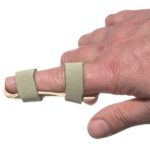Trigger Finger

My mother-in law was an avid gardener. From early spring to late autumn, she was rarely seen without a pair of pruning shears in her hand. One day when I stopped by for a visit, she told me she was having the oddest problem in her index finger. Slipping her right hand out of her gardening glove, she proceeded to show me how when she made a fist and then opened her fingers straight out, her index finger remained bent. Then she demonstrated for me how she could tug on it and “pop” it out straight again.
I smiled, knowingly, as my mother-in-law was experiencing a common orthopedic problem known as trigger finger. Named for the mechanical “snap” or “pop” which is similar to the pull and release of a gun’s trigger, this condition affects women, more often than men, who perform repetitive gripping motions with their hands.
The malady of a trigger finger occurs when the flexor tendon which bends the finger can no longer glide freely inside its encompassing sleeve (sheath). The reason for this issue is not lack of lubrication, as one might think, but rather it’s due to inflammation of the sheath itself, which has typically occurred from the frictional forces of overuse.
There are two main treatment options for trigger finger. The first is rest from the aggravating activity, along with donning a brace/splint which holds the finger in a straightened position. The second, which in my opinion is the quickest and most effective treatment, is the administration of an anti-inflammatory (steroid) medication via a local injection. This is only mildly uncomfortable, but will require a trip to an orthopedist’s office. Within a few days of this injection, most find their finger has lost its trigger!